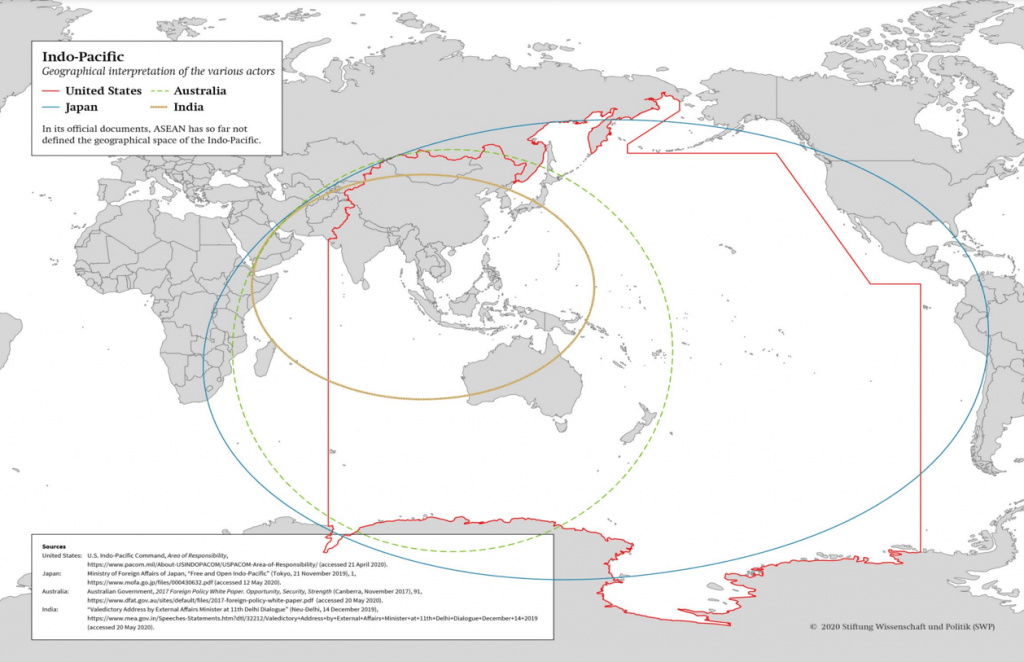
The Indo-Pacific region is a political term to dub the geopolitical area that stretches from the west coast of the United States (U.S.) to the west coast of India. It connects the tropical waters of the Indian Ocean with the western and central Pacific Ocean and is made up of twenty-four countries, all of which have remarkably different political structures and levels of power. The term “Indo-Pacific” initially used by the Obama Administration[1] and announced by the Secretary of State Hillary Clinton to define the U.S. strategic plans to connect Indian and Pacific Oceans with an Indo-Pacific Economic Corridor (IPEC) and through the political and military “pivot to Asia” is increasingly superseding the previously common term “Asia-Pacific”. President Barack Obama’s foreign policy response to the rise of China was combining economic, diplomatic, and cultural engagement with military containment. [2] The policy of containment and engagement towards China stands on the policy of intensive engagement with China, which has been executed since President Richard Nixon’s 1972 visit. However, China’s growing strength, and its economic mercantilism led Trump and Biden administrations to distance from engagement as they perceived China’s stance as a challenge to the U.S. global leadership. The map below displays how the roads for hegemonic and regional powers to international engagement cross as the global order continues to shift first to the Asia-Pacific trade axis then to the Indo-Pacific Region.[3]

US – China Rivalry in the Region
Obama followed his predecessor George W. Bush administration’s example and sought to rebalance in Asia-Pacific through adopting a burden-sharing strategy with NATO and sliding a significant part of the U.S. military presence from the Middle East to the Asia-Pacific region and consolidating economic multilateralism. The cuts, which have been made to overseas contingency operations in Iraq and Afghanistan during the Obama administration would be channelled to new investments in high-end military capabilities, such as cyber and space warfare, stealth technology, drones, and precision-guided weaponry to maintain long-term military edge against China’s military modernization programmes and deny China military hegemony in the South and the East China Seas.[4] Despite the election of Donald Trump in 2016, the U.S. foreign policy showed continuity in terms of rebalancing strategy toward the Asia-Pacific with a focus on China in particular and a geopolitical aim of maintaining American power in the region. The Trump administration, for instance followed in the footsteps of Obama’s commitment to work with China to reduce the risk of North Korea’s nuclear arms, albeit with less persuasion and more intimidation. The U.S. insisted that China acts as an intermediary for the talks with North Korea, conveying the necessary messages and demanded that it persuades North Korea to cooperate. Although the Trump administration seemed to use trade wars to press China for this objective[5], it was Beijing who was willing to become a responsible stakeholder and highlight the emergence of a multipolar world. China apparently prefers deescalating tensions to a policy of regime change, which may have wider and negative repercussions within the region. Indeed, the U.S. response to Russia-Ukraine War may lead the Indo-Pacific countries to have second thoughts about labelling China as an adversary or transforming NATO into a global alliance. Despite territorial disputes, rest of the Indo-Pacific countries refer to regional alignments and platforms to preserve dialogue with friend and foe alike. The emergence of a multipolar world expresses itself through regional alignments in the Indo-Pacific.
A new Economic and Political Hub?
Although the Indo-Pacific region is becoming the new economic and political hub of the world, the geographic maps we are accustomed to viewing do not necessarily fit in the existing political dimensions. Thus, centring the Indo-Pacific may broaden our perspective and help us appreciate how regional alignments have evolved alongside security alliances. The central position of the Indo-Pacific becomes apparent as security and economic competition with China intensifies. Foreign policy strategy of the U.S. has included moving closer to emerging partners like India and Vietnam, strengthening relationships with leading regional partners, including Indonesia, Malaysia, Mongolia, New Zealand, Singapore, Taiwan, and deepening regional treaty alliances with Australia, Japan, South Korea, the Philippines, and Thailand. The U.S. foreign policy needs to adapt to the changing post-war international regime and perhaps develop/accept a complementary role for the surviving bilateral alliances of the U.S. ‘hub and spoke’ system in the Asia-Pacific.
Robert Osgood defines an alliance as a formal agreement that commits states to working together to use their military resources against a particular state or states, and an alliance typically requires one or more signatories to use force or to consider using force (unilaterally or in consultation with allies) in certain situations.[6] The U.S. has not spared in signing military alliances with Asia-Pacific countries and provided the much needed security and guarantee when the Cold War was at its peak. Thus, these countries were able to mobilize their resources for development. Yet, instead of overstretching its capacity and establishing a multilateral structure such as NATO, the U.S. turned to a series of bilateral alliance pacts with regional strategic partners.
The U.S. hub-and-spokes system of alliances includes but not confined to the San Francisco Peace Treaty in 1951, which establishes the foundation of the Japan-US alliance and the Australia, New Zealand, United States Treaty (ANZUS) military alliance, which was broken up due to New Zealand’s non-nuclear policy and U.S.-Philippines Mutual Defence Treaty. The U.S. has also signed alliance pacts with South Korea (1953), Thailand (1954), and Taiwan (1954, which would be replaced with Taiwan Relations Act). Strategic partnerships are a loose form of alignment, with a flexible and non-binding nature. The U.S. is also pursuing strategic partnerships with smaller states that are reluctant to sign rigid and binding agreements. This provides the opportunity for the Indo-Pacific countries to mix and match collaborations from different security, economic, and diplomatic alignments. The U.S. hub-and-spokes system of alliances stands as the oldest and the most deeply rooted pillar of three alignment blocs in the Asia-Pacific, with Shanghai Cooperation Organisation (SCO) strategic partnership, and the ASEAN security community. These three blocs of alignments are functional in transforming the regional order and reshaping it through complicated networks. Though the multitude of regional agreements, regimes, and institutions in the Indo-Pacific calls into mind the definition of “noodle-bowl”, it is well adjusted to the multiplicity of needs and quest of regional states and represents the development of a contemporary world of alignments rather than alliances. The U.S.’s call for support to the “war on terror” has temporarily revitalized the U.S. alliance with Asian states. Again the U.S. has been pushing for deeper military integration and security cooperation under the “Free and Open Indo-Pacific” (FOIP) vision to check Chinese assertiveness in the South China Sea and Indian Ocean. Yet, it would be more accurate to call the Trilateral Strategic Dialogue (TSD) process between the U.S., Japan and Australia and India’s participation into the “Quad” process merely “strategic partnerships”, which are the extension of the existing hub-and-spoke system. Since the Trump administration abolished the Trans-Pacific Partnership (TPP) in 2017, the U.S. has done little to fill in the gap and offer a clear, comprehensive regional strategy that goes beyond a strategic partnership confined to the security of an exclusive “club”.
Regional IOs in the Indo-Pacific: SCO and ASEAN
The contemporary security issues are transcending the traditional regional security paradigm in scope and comprise a gamut of challenges such as the spread of infectious diseases, natural disasters, resource scarcity, climate change and environmental degradation, migration pressures, transnational crime, but also threats such as state sponsored violence on domestic populations and the emergence of non-state armed actors. Some of these security concerns, whether local or global in scope, call for the management of non-military threats to the security of environment, societies, and individuals. These challenges also necessitate international cooperation if they exceed national resources and capacity. It reveals the importance of bilateral and regional alignments in such situations. Shanghai Cooperation Organisation (SCO) strategic partnership network on the one hand represents a formal organisation established to handle non-traditional security concerns namely, terrorism, separatism, and religious extremism, on the other hand serves as a platform to promote a multipolar world order.[7] This network attracts countries across the Eurasian region that see benefit in a “web” of bilateral strategic partnerships. Thus, China superintends an exclusive multilateral arrangement, which has gradually extended membership from Shanghai Five to admit the Central Asian states of Kazakhstan, Uzbekistan, Kyrgyzstan, and Tajikistan, and to include cautious opponents India and Pakistan. Countries holding Observer Status and Dialogue Partners from Asia far and wide reveal how China has become a centre of gravity. According to Wilkins SCO stands out as an alternative centre of power in the Indo-Pacific and a possible rival to the regional order that Washington and its allies support.[8] The multiple fields of operation ranging from diplomacy to security and economy and the potential for joint energy projects, new financial architecture, and development funds backed by China makes this hybrid security alignment distinctive. The SCO also covers areas related to intelligence, cyber, and social-cultural issues. This organisation is valuable since it provides a platform for dialogue among its members, however it has not been able to keep Chinese assertiveness in the South China Sea at bay or prevent Russian aggression in East Europe. It is not comparable to NATO in Europe and is completely different from the U.S. hub-and-spoke alliance.
ASEAN security community was first established as a regional intergovernmental organisation in 1967 in defence against the interventions by the communist states of Vietnam and China.[9] It has steadily developed into a non-alliance alternative to the SCO and a network that supports military, educational, economic, political, security, and social integration efforts. ASEAN members believe that their security is promoted collectively, even though they stay distant to a collective defence agreement. It is crucial for Indo-Pacific’s middle powers to make sure that the Sino-U.S. rivalry does not negatively impact their interests and security. Yet, they recognise the need to defend against Chinese coerciveness. Thus, these middle powers are aligning to adapt to the changing dynamics in the Indo-Pacific and they are following a proactive diplomacy. The ASEAN security community has provided the ground for such a diplomacy through lobbying, insulating and rulemaking in the domains of security, trade, and international law. The so-called “Asian Way” is not a simplistic assertion of “Asian” values instead of “Western”. Again, it is an effort to solidify Asia’s central situation in the geopolitical and economic map. ASEAN members have been successful in mediating tensions between Southeast Asia and external powers through multilateral institutions including but not limited to the ASEAN Regional Forum, ASEAN+3 (Japan, the Republic of Korea and China), East Asian Summit (ASEAN + 3 with India, Australia, and New Zealand-signatories of ASEAN’s Treaty of Amity and Cooperation), and ASEAN Defence Ministers Meeting+ and the Regional Comprehensive Economic Partnership. Unfortunately, ASEAN members lack a common vision since their priorities differ, and they have not settled their territorial disputes. ASEAN members seem to have at least agreed on the principles of non-interference in the internal affairs and the peaceful resolution of conflicts. Still, the current security problems of the region bring to mind the question of how applicable ASEAN’s consultation and consensus norms are.
Indo-Pacific corresponds to a wider regional security order in the process of formation. U.S.-aligned middle powers of the region, such as Australia, Japan, Canada, and India may well create a synergy for cooperation with or without U.S. involvement as long as they can mobilise their capability-based contributions for dealing with regional security issues. Indo-Pacific region can benefit from preserving free flow of data, providing disaster relief and quick response to humanitarian crisis, defending the liberty of movement in international waters, cooperating with regional states in their efforts to mitigate and adapt to climate change. These non-traditional security issues may have a diverse nature, but they can support convergence of interests and even create a spill-over effect. The regional states are no stranger to alignments after all. Yet, it may not be persuasive enough for emerging states to embrace a collective defence pact. Instead, traditional American allies – Australia, Japan, and India – contribute to the construction of the concept of the Indo-Pacific as an area of cooperation. IPEC would foster economic cooperation and present an alternative to Xi Jinping’s Belt and Road Initiative. Yet, U.S. strategy to unify the Pacific and Indian Oceans as “a single and key maritime entity”[10] would not only provide trade integration, but also physical connectivity through a beneficial economic corridor within Southeast and South Asia, which strategic partners would be more than inclined to defend. The need to facilitate and preserve global flows through transportation infrastructure especially when bottlenecks are identified, or free movement in international waters are threatened by Chinese claims, might serve as a unifying goal for coastal states. However, the U.S. would not succeed in initiating a free trade area confined to the U.S. allies and partners in the region. On the contrary, the U.S. would withdraw from the Trans-Pacific Partnership, a multilateral trade agreement. This would clearly mark that the U.S. economic power and appeal was lagging behind China. In return, the U.S. increasingly leans on bilateral deals with regional powers rather than multilateral platforms such as ASEAN. Indeed, ASEAN was a produce of the U.S. dominated regional order. Still, the U.S. hardly embraces multilateralism in the region. The regional powers are thus inclined to define a free and open Indo-Pacific according to individual norms and further distance from taking collective action since the U.S. shades multilateral organizations with scepticism.[11] Eventually, regional powers have resorted to draw individual spheres of influence and interests in the region. Building a culture of constructive cooperation becomes more difficult under these conditions. For now, these countries avoid from stepping on one another’s toes. However, the naval capacity of the regional powers may once again determine who will be the next maritime power in the region.

The U.S. Indo-Pacific strategy combines internal balancing, so-called “America First” principle, since the term was coined by the Trump Administration, with external balancing. Thus, the U.S. would respond to China immediately and adopt necessary measures to level the conditions for the American businesses. Trump’s economic nationalism would accompany protectionism. In the meantime, external balancing would set two goals: first starting and managing formal alliances, secondly establishing bilateral relationships with Indo-Pacific allies and partners for external balancing in the wider Indo-Pacific. Yet, relatively weaker powers did not automatically join a balancing coalition with China’s neighbours to contain Beijing. They preferred balancing with the U.S. against China, while preserving “their own hedging strategies”.[13] These strategies overlap on the geographical interpretation of the region like concentric circles. However, the circumference of each circle differs. Japan’s Free and Open Indo-Pacific strategy closely coincides with the wide geographical interpretation of the U.S. In December 2017 the U.S. adopts the same concept Free and Open Indo-Pacific (FOIP) with Japan and stresses the four principles: respect for the sovereignty and independence of all states, peaceful conflict resolution, free trade, and respect for international law. First three of these principles do not seem to contradict with the foreign policy principles or at least rhetoric of China. China was not ostensibly excluded from the regional integration and developments in FOIP. Since 2019, however, the U.S. State Department defines China as a primary opponent, a competitor and “a revisionist power”, as it increasingly undermines openness – free access to international waters, airspace, and digital space. China, however, interprets openness as free access to regional markets through a regionalism established and enforced by state-directed infrastructure investment. China is also blamed for undermining the rules-based international order, in other words challenging American order. For China, displacing the U.S. hegemony in the region will open the door for Beijing to project leadership over global governance.[14] China raises its game and switches from undermining American dominance by maritime denial to establishing new order by sea control. Doshi states that Chinese military investment in aircraft carriers, capable surface vessels, amphibious warfare, marines, and overseas bases prove that Beijing does not fear from making the U.S. feel vulnerable or unsettling its neighbours anymore.[15] On the contrary, China develops its force structure in response to the geographical interpretation of the various actors including the U.S., Japan, India, and Australia.
Conclusion: What’s next in the Region?
While it has been revealed that America neither designed a new order in the Indo-Pacific nor has the opportunity and capacity to maintain the old order, for now the regional powers are filling this gap with the bilateral and multilateral relations they have established with allied and rival powers. On the one hand the U.S. resists accepting the apparent emergence of a multipolar world, on the other hand lacks the political strategy or vision to organize allies and partners more tightly around the existing regional alignments. Scott argues that U.S. Indo-Pacific strategy is using one rising power (India) to help constrain another rising power (China).[16] However, India’s Indo-Pacific concept reflects a preoccupation to ensure India’s maritime security. New Delhi clearly prioritizes security over economic issues. The discomfort from increasing activities of Chinese military vessels in the Indian ocean and the perceived threat to the freedom of navigation in the South China Sea make India to intensify security cooperation with United States, Japan, Australia, and Southeast Asia. However, India is an advocate of a multipolar world and stands away from any idea of exclusionary regional pacts let alone an American formulation of FOIP. India follows a delicate counterbalancing policy against China, which does not exclude cooperation with Beijing. While India contributes to maritime exercises with the U. S., Japan, Australia, and Southeast Asian countries, it joins in BRICS and SCO with China. Neither India nor Japan wants to be restricted by an alliance created to contain China.
Japan refrains from formulating FOIP as a containment strategy against China and resorts to a so-called FOIP vision that is supposedly capable of coexisting with and even complementing China’s Belt and Road Initiative. Meanwhile, Japan is content with the security guarantee provided by the alliance with the U.S. With the other partners, however, Japan welcomes increased security cooperation rather than a defence alliance. For Japan, FOIP comes to mean increased connectivity, infrastructure development and economic growth in two oceans, but not hard policy issues that may pull Tokyo into a direct conflict with Beijing. Japan may also regain its foregone economic weight in the region. With such an expectation Tokyo has filled in the void the U.S. has left with its withdrawal from TPP. Japan regards Regional Comprehensive Economic Partnership as another opportunity to play an important role in the region.
Australia’s
Indo-Pacific concept coincides with both India’s and Japan’s in terms of
emphasizing the importance maritime security and freedom of navigation. Besides
Australia agrees with India and Japan to extend the Western border of the Indo-Pacific
as far as East Africa, where China is already active and developing economic
and diplomatic ties. Australia is another state, which benefits from the
American security guarantee in the region. Australia also complements the U.S.-Australian
alliance with bilateral and in group cooperation with the regional states that
share most in common with Australia in terms of liberal and democratic
institutions and values. All three states constitute major democracies in the
region and consider preserving universal values, and compliance with
international law as vital to maintain stability in the region. As long as the
status quo is not challenged, regional states can and will pursue economic
relations with China, their principal economic partner, whereas the U.S. will
remain as the main security partner. However, the future of this complicated
web of relations depends on whether the U.S. and China will behave responsibly
or escalate conflicts through disruptive policies.
[1] Hillary Clinton (2011). “America’s Pacific Century.” Foreign Policy, 11 October 2011, https://foreignpolicy.com/2011/10/11/americas-pacific-century/ (Accessed 07/10/2022).
[2] David J. Bertau, Michael J. Green and Zack Cooper (2014). Assessing the Asia-Pacific Rebalance. Lanham and Boulder: Rowman and Littlefield, https://csis-website-prod.s3.amazonaws.com/s3fs-public/legacy_files/files/publication/150105_Berteau_AssessingAsiaPacificRebal_Web.pdf (Accessed 07/10/2022).
[3] Andre Wheeler (2020). “Has China’s Belt and Road Initiative Shifted the Geopolitical Regional Debate from APAC to the Indo-Pacfic?” Silk Road Briefing, 04 November, https://www.silkroadbriefing.com/news/2020/11/04/has-chinas-belt-and-road-initiative-shifted-the-geo-political-regional-debate-from-apac-to-the-indo-pacific/ (Accessed 07/10/2022).
[4] Stephen Biddle and Ivan Oelrich (2016). “Future Warfare in the Western Pacific: Chinese Antiaccess/Area Denial, U.S. AirSea Battle, and Command of the Commons in East Asia.” International Security, 41 (01), 7–48. http://www.jstor.org/stable/24916870 (Accessed 07/10/2022).
[5] Michael Swaine and Bruce Klingner (2017). “What’s the Best Way for Trump to Persuade China to Up the Pressure on North Korea?” ChinaFile, 25 April 2017, https://www.chinafile.com/conversation/whats-best-way-trump-persuade-china-pressure-north-korea (Accessed 07/10/2022).
[6] Robert E. Osgood (1968). Alliances and American Foreign Policy. Baltimore, Md: Johns Hopkins Press.
[7] The SCO currently comprises eight Member States (China, India, Kazakhstan, Kyrgyzstan, Russia, Pakistan, Tajikistan and Uzbekistan), four Observer States interested in acceding to full membership (Afghanistan, Belarus, Iran, and Mongolia) and six “Dialogue Partners” (Armenia, Azerbaijan, Cambodia, Nepal, Sri Lanka and Turkey). http://eng.sectsco.org (Accessed 07/10/2022).
[8] Thomas S. Wilkins (2011). “‘Alignment’, not ‘alliance’ – the shifting paradigm of international security cooperation: toward a conceptual taxonomy of alignment.” Review of International Studies, 38(01), 53–76. doi:10.1017/s0260210511000209
[9] Founding members of the ASEAN are Indonesia, Malaysia, Philippines, Singapore, and Thailand. Brunei Darussalam joined ASEAN on 7 January 1984, followed by Viet Nam on 28 July 1995, Lao PDR and Myanmar on 23 July 1997, and Cambodia on 30 April 1999, making up what is today the ten Member States of ASEAN. https://asean.org/about-asean__trashed/member-states/ (Accessed 07/10/2022).
[10] Sebastian Bobowski and Pawel Passierbiak (2018). “An Indo-Pacific Economic Corridor-Premises and Implications of the U.S. Project.” The 12th International Day of Statistics and Economics, Prague, 6-8 September 2018, p. 207, https://msed.vse.cz/msed_2018/article/210-Bobowski-Sebastian-paper.pdf (Accessed 07/10/2022).
[11] Felix Heiduck and Gudrun Wacker (2020). “From Asia-Pacific to Indo-Pacific: Significance, Implementation and Challenges.” SWP Research Paper 9, p.17, https://www.swp-berlin.org/publications/products/research_papers/2020RP09_IndoPacific.pdf (Accessed 07/10/2022).
[12] Felix Heiduck and Gudrun Wacker (2020). “From Asia-Pacific to Indo-Pacific: Significance, Implementation and Challenges.” SWP Research Paper 9, p.10, https://www.swp-berlin.org/publications/products/research_papers/2020RP09_IndoPacific.pdf
[13] Ibid.
[14] Rush Doshi (2021). “The Long Game: China’s Grand Strategy to Displace American Order.” Brookings, 2 August 2021, https://www.brookings.edu/essay/the-long-game-chinas-grand-strategy-to-displace-american-order/ (Accessed 07/10/2022).
[15] Ibid.
[16] David Scott (2018). “The Indo-Pacfic in US Strategy: Responding to Power Shifts.” Rising Powers Quarterly, 3(2), 19-43, https://risingpowersproject.com/the-indo-pacific-in-us-strategy-responding-to-power-shifts/ (Accessed 07/10/2022).

Assoc. Prof. Sanem Özer , Akdeniz University
Sanem Özer is associate professor of International Relations at Akdeniz University, Faculty of Economics and Administrative Sciences. She graduated from Bilkent University, Department of English Language and Literature in 1999. She earned her MA on European Studies in the University of Exeter, UK and her PhD on EU Politics and International Relations with her thesis “A Common Foreign Policy towards the Caucasus? With Special Reference to Some EU Member States” in the European Union Institute, Marmara University, Istanbul. She had a Rotary Peace Fellowship for Professional Development Certificate Program in Chulalongkorn University, Bangkok, Thailand in 2013. She is also the editor of one national book on the politics of Asia-Pacific and the author of many national and international book chapters and articles. She gives lectures on conflict resolution, Asia-Pacific politics, migration and the politics of energy.
To cite this work : Sanem Özer“The Future of Alignments in the Indo-Pacific”, Panorama, Online , 12 October 2022, https://www.uikpanorama.com/blog/2022/10/12/indo/
Copyright@UIKPanorama. All on-line and print rights reserved. Opinions expressed in works published by the Panorama belongs to the authors alone unless otherwise stated, and do not imply endorsement by the IRCT, Global Academy, or the Editors/Editorial Board of Panorama.


